The island of Kyushu is located southwest of the main island of Japan. Surrounded by the Pacific Ocean, the Japan Sea and the East China Sea, Kyushu has had active interactions with foreign countries since ancient times. Carrying on this tradition, Kyushu welcomes visitors from other countries. The island of Kyushu consists of seven prefectures–Fukuoka, Saga, Nagasaki, Kumamoto, Oita, Miyazaki and Kagoshima–and it’s highly recommended that visitors experience the cultural differences of these prefectures. The climate of Kyushu is generally mild, so it’s ideal for travel. For example, the average temperature of Fukuoka Prefecture is 18゚C throughout the year, which makes it a comfortable place to visit. However, there are distinct seasonal differences with the temperature of over 27゚C in August (summer) and below 6゚C in January (winter). Thus there are various ways to enjoy each season. For example, visitors can admire blossoming flowers in spring, immerse themselves in the great nature in summer, enjoy fresh food from the mountains and the ocean in the fall, and relax in the hot springs in winter.
The island of Kyushu is, for many reasons, popular among foreigners as a region that’s safe and comfortable for travel. For example, the natural water of Kyushu is considered to be among the tastiest, safest water in Japan. Tap water is completely safe to drink, and especially in Kumamoto Prefecture, most tap water is derived from the natural subsoil water. It has a great natural taste and is known to contain minerals that are good for the health. Well-organized transportation system is another reason to make this region a travel destination. Visitors can get to any tourist spot using trains and buses. The Kyushu Shinkansen, which connects the southern and northern tips of the island, is quite convenient. It can take passengers from Hakata Station to Kagoshima Chuo Station in 1 hour and 17 minutes in the fastest train. Additionally, foreign travelers can benefit from the exclusive JR Kyushu Rail Pass, which allows unlimited use of any JR lines within the island of Kyushu from 14,000 yen for three days. Most rental cars are equipped with an English-language GPS that makes it easy for foreigners to travel.
There are many activities we would recommend in Kyushu, but a visit to the hot springs is a must. Hot springs are scattered over different regions in Kyushu. Starting with the world-famous Yufuin (Oita Prefecture) and Beppu (Oita Prefecture), there are also Kurokawa (Kumamoto Prefecture), Aso (Kumamoto Prefecture), Obama (Nagasaki Prefecture), Unzen (Nagasaki Prefecture), and Ibusuki (Kagoshima Prefecture). A visit to the hot springs will be one of the most memorable experiences of your trip. We also recommend that you challenge Kyushu Olle, a Japanese application of the “Jeju-do Olle,” which is a new trail-walking style that began on Jeju-do Island in South Korea. You can feel the goodness of Kyushu with all your senses.
The island is Kyushu is easy to travel, and visitors can enjoy regional differences with convenient access to all tourist spots. Given the variety of ways to enjoy this beautiful island, many foreigners return for more excitement.
Kinwashi Tour Japan Thread
-
-
Dual hydrogen, gas station opensYomiuri -- Apr 20
The nation's first hydrogen refueling station to be integrated with a gas station opened Friday in Ebina, Kanagawa Prefecture, playing a part in the spread of "ultimate eco-friendly" fuel cell cars.The station is the 17th hydrogen station to open in Japan and is part of a verification experiment jointly conducted by the Research Association of Hydrogen Supply/Utilization Technology (HySUT), JX Nippon Oil & Energy Corp. and other -
Introduction to Kyushu
-
source.
Most will go for this.


Nakasu/Tenjin Areaä¸å·ž/天神エリア
Fukuoka�岡県
Nakasu is the busiest street on Kyushu. Tenjin is popular as a fashion capital and is a popular shopping spot.
Nakasu is the busiest street on Kyushu, located in the eastern part of Fukuoka City, and between the Naka-gawa and the Hakata-gawa rivers. About 3,500 restaurants stand close together in Nakasu, street stalls line the Naka-gawa River, and large-scale shopping centers such as Hakata Riverain, cooperate with each other to produce the din and bustle of the amusement district.
Tenjin is a gorgeous area, with the business streets in harmony with the shopping streets. Large department stores, boutiques, and composite multi-function buildings are concentrated here. Fashionable coffee shops, restaurants, and everyday goods stores have been opening one after another.
In the evening, from Haruyoshi-bashi Bridge in Nakasu to Daimaru Department Store, or along Showa-dori Street, street stalls, which are a feature of this district, stand side by side to serve a variety of dishes such as Chinese noodles, 'oden,' tacos, and pizzas to you in a casual manner. Young or old, men or women, whoever is sitting next to you is your friend. Such an atmosphere is enjoyed at the stalls.
-
Food Stalls (Yatai) 
# 2 of 7 most visited
sights in Fukuokajump to: access - hotels - ratings - shops - links 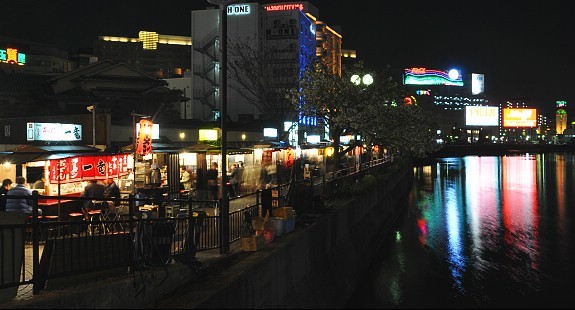 Fukuoka's famous food stalls (yatai) located along the river on Nakasu Island
Fukuoka's famous food stalls (yatai) located along the river on Nakasu Island
Fukuoka's open air food stands (屋�, Yatai) are possibly the city's best known symbol. Yatai can generally seat about seven or eight people and provide an atmospheric outdoor environment to enjoy various foods that are generally simple and filling. There are over 150 yatai scattered across Fukuoka but the best place to find them is on the southern end of Nakasu Island. Located in the middle of the city, Nakasu Island has a long row of around 20 yatai that are attractively situated along the water.
Typical dishes to be enjoyed at yatai are grilled chicken skewers (yakitori), hot pot (oden) and most famously Hakata Ramen, a local noodle dish featuring relatively thin ramen noodles in a pork bone based soup (tonkotsu). Various alcoholic drinks are also available, and help make the yatai a great place to get in touch with the locals, although many of the "locals" happen to be Japanese tourists visiting Fukuoka from other parts of Japan.
Yatai are typically open from around 6pm to around 2am, except when the weather is very bad. Many stands remain closed on one day of the week. The closure day varies from stand to stand, but is often Sunday. There can be waiting times for popular stands, especially on Fridays and Saturdays.
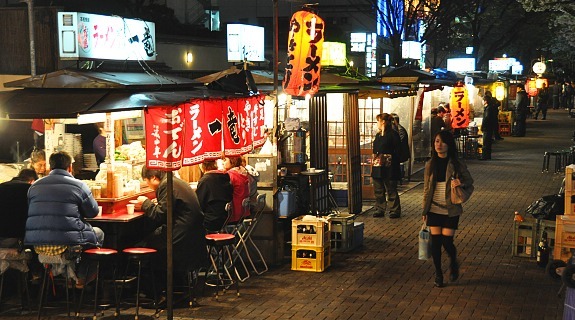 A closer view of some of Nakasu's food stalls
A closer view of some of Nakasu's food stalls -
Home - Food Popular Dishes jump to: links Japanese cuisine offers a great variety of dishes and regional specialties. Some of the most popular Japanese and Japanized dishes are listed below. They are categorized below into rice dishes, seafood dishes, noodle dishes, nabe dishes, meat dishes, soya bean dishes, yoshoku dishes and other dishes. Please note that some dishes may fit into multiple categories, but are listed only once. For over 2000 years, rice has been the most important food in Japanese cuisine. Despite changes in eating patterns over the last few decades and slowly decreasing rice consumption in recent years, rice remains one of the most important ingredients in Japan today.
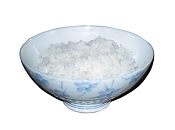
Rice Bowl A bowl of plain cooked rice is served with most Japanese meals. For breakfast, it is sometimes mixed with a raw egg and soya sauce (tamago kake gohan) or enjoyed with natto or other toppings. 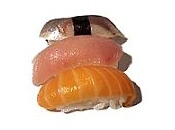
Sushi (more info) Sushi may refer to any dish that contains sushi rice, cooked white rice flavored with seasoned rice vinegar. There are various kinds of sushi dishes, such as nigirizushi (hand formed sushi), makizushi (rolled sushi), and chirashi (sushi rice topped with raw fish). Sushi is the most famous Japanese dish outside of Japan, and one of the most popular dishes among the Japanese themselves. 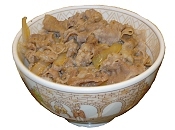
Donburi (more info) Donburi refers to a bowl of plain cooked rice with some other food on top of it.Donburi are served at specialty restaurants, but they are also a common dish that can be found on all kinds of restaurants' menus. Some of the most popular varieties are gyudon (stewed beef), katsudon (tonkatsu), tendon (tempura), oyakodon (chicken and egg), tekkadon (maguro), and kaisendon (raw seafood). 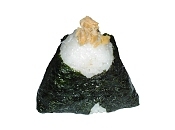
Rice Balls (Onigiri) Rice balls, or Onigiri, are made of cooked rice and are usually wrapped in noriseaweed. They are usually lightly seasoned with salt and often contain a filling such as umeboshi (pickled Japanese plum), okaka (dried bonito shavings and konbu), or salmon. Rice balls are a popular and inexpensive portable snack available at convenience stores, but are also commonly served at general restaurants and izakaya. 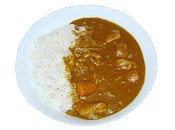
Kare Raisu (Curry Rice) (more info) Kare Raisu (Curry Rice) is cooked rice with a Japanese curry sauce. It can be served with additional toppings such as tonkatsu. Curry is not a native Japanese spice, but has been used in Japan for over a century. Kare Raisu is a very popular dish, and many inexpensive Kare Raisu restaurants can be found especially in and around train stations. 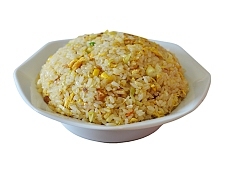
Fried Rice (Chahan) Fried rice, or chahan, is a dish that was originally introduced from China. There are an infinite variety of ingredients that can be added to fried rice. Some common ones are peas, egg, green onions (negi), carrots and pork. Chahan is a suitable dish for using left over rice. 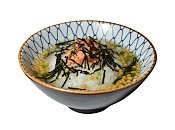
Chazuke (Ochazuke) Chazuke, or ochazuke, is another simple comfort food consisting of hot water, tea, or light fish stock poured over rice (sometimes made with leftover rice). Chazuke is often garnished with toppings such as umeboshi, grilled salmon, orpickles. Chazuke is commonly served at izakaya, and is a popular dish to eat after drinking. 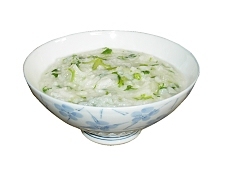
Kayu Kayu, or okayu, is Japanese rice porridge made by slow cooking rice in lots of water. It tends to be thicker than other types of rice porridge or gruel, and is a suitable dish for using left over rice. Kayu is often garnished with umeboshi, and is commonly served to sick people because it is easily digestible. Hundreds of different fish, shellfish and other seafood from the oceans, seas, lakes and rivers are used in the Japanese cuisine. They are prepared and eaten in many different ways, such as raw, dried, boiled, grilled, deep fried or steamed.
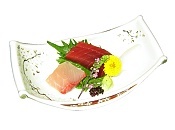
Sashimi (more info) Sashimi is raw seafood. A large number of fish can be enjoyed raw if they are fresh and prepared correctly. Most types of sashimi are enjoyed with soy sauceand wasabi. 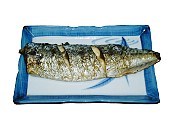
Yakizakana Yakizakana means grilled fish. Many varieties of fish are enjoyed in this way, including mackerel (saba), salmon (sake), mackerel pike (sanma), horse mackerel (aji), Okhotsk atka mackerel (hokke), sea bream (tai) and sweetfish (ayu). There are various traditional Japanese noodle dishes as well as some dishes which were introduced to Japan and subsequently Japanized. Noodle dishes are very popular in Japan, and are served both hot and cold depending on the season. Noodle restaurants and food stands are ubiquitous, and it is common to find noodle stands along train platforms.
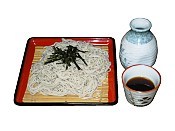
Soba (more info) Soba are native Japanese noodles made of buckwheat flour or a mixture of buckwheat and wheat flour. Soba are about as thick as spaghetti, and are served either hot or cold and with various toppings. 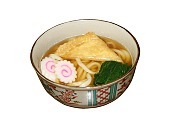
Udon (more info) Udon are Japanese noodles made of wheat flour. Udon are thicker than soba and are also served either hot or cold and with various toppings such as fried tofu (kitsune udon), tempura (tempura udon), and mountain vegetables (sansai udon). 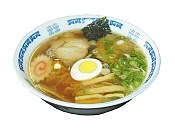
Ramen (more info) Ramen is Chinese style noodles prepared in a soup with various toppings. Ramen is one of the many popular dishes that were originally introduced from China but have become completely Japanized over time. 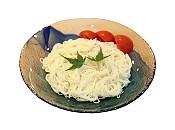
Somen Like Udon noodles, somen are Japanese noodles made of wheat flour, but they are much thinner than Udon and Soba. Somen are usually eaten cold and are considered a summer speciality. 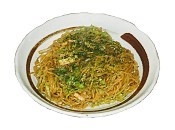
Yakisoba Yakisoba are grilled or fried Chinese style noodles mixed with pieces of meat, cabbage, carrots, or other vegetables, and garnished with red ginger. It is a popular festival food. Nabe, or hot pot dishes, are prepared in a hot pot, usually at the table. Typical ingredients are vegetables such as negi (Japanese leek) and hakusai (Chinese cabbage), various mushrooms, seafood and/or meat. There are many regional and personal varieties, and they are especially popular in the cold winter months. Some special nabe dishes are:
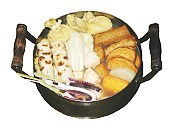
Oden A nabe dish prepared with various fish cakes, daikon, boiled eggs, konyaku andkombu seaweed, slow simmered in a soy sauce based soup. Oden is a popular dish available at convenience stores in the winter. 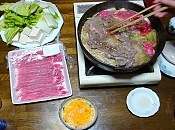
Sukiyaki A nabe dish prepared with thinly sliced meat, vegetables, mushrooms, tofu and shirataki (konyaku noodles) simmered in a sweet soy sauce broth. The pieces of food are dipped into raw beaten egg before being eaten. 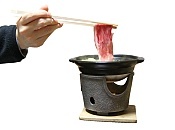
Shabu Shabu Shabu shabu is Japanese style meat hot pot where pieces of thinly sliced meat, seafood, vegetables, mushrooms and tofu, are cooked by dipping them into a hot soup. The bite sized pieces are then dipped into a ponzu citrus or sesame sauce before being eaten. 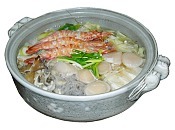
Chanko Nabe Chanko nabe is the traditional staple diet of sumo wrestlers. There are many varieties of chanko nabe, which can be tried at one of the several specialty chanko nabe restaurants found around Ryogoku, the sumo district in Tokyo. Meat has been eaten in Japan in larger amounts only since the second half of the 19th century. Nowadays there are a variety of popular Japanese meat dishes.
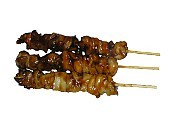
Yakitori (more info) Yakitori are skewered grilled chicken pieces seasoned with salt or sauce. Almost every part of the chicken is used for yakitori including the white and dark meat, gizzards, skin, and other organs. 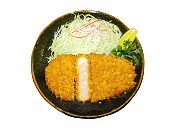
Tonkatsu Tonkatsu are deep fried pork cutlets. Tonkatsu is usually served accompanied by shredded cabbage or on top of cooked rice (katsudon). It is also a common addition to Japanese style curry rice (katsu kare). 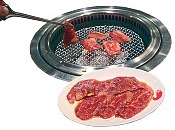
Yakiniku Yakiniku literally means "grilled meat" and refers to grilling bite-size pieces of meat - mostly beef and pork - on a grill at the table. Specialized yakiniku restaurants are among the most popular restaurant types in Japan and usually serve a wide variety of meat parts at multiple quality (and cost) levels. 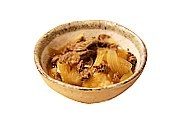
Nikujaga (more info) Nikujaga is a popular dish of home style cooking made of sweet stewed meat (niku) and potatoes (jagaimo). 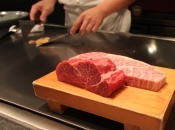
Teppanyaki Meat, seafood and vegetables are prepared on a large iron griddle (teppan) around which the diners are seated. The chef artfully prepares the dishes in front of his customers. Tofu, natto, miso and many other important ingredients of Japanese cooking are made of soybeans. The following are some of the most popular soybean based dishes:
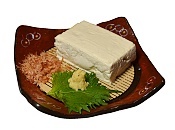
Hiyayakko Hiyayakko is fresh chilled tofu (usually soft tofu) commonly garnished with grated ginger, katsuobushi (shaved bonito flakes), and green onions and seasoned with soy sauce. Diners should pour a little soy sauce over the tofu before eating it if it did not come already seasoned. 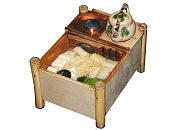
Yudofu Yudofu are tofu pieces boiled in a clear, mild soup and dipped into soy sauce or ponzu (citrus sauce) before being eaten. Yudofu is a specialty of Kyoto and commonly served during the colder winter months. 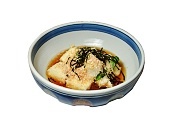
Agedashidofu Agedashidofu is made of lightly breaded tofu which is fried and served hot in a dashi soy sauce broth and commonly garnished with green onions or grated daikon. Agedashidofu can be found in a variety of restaurants and is commonizakaya food. 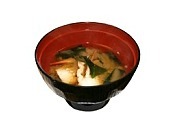
Miso Soup Miso soup is made by dissolving miso paste in dish stock (dashi). Common additions include wakame seaweed, small pieces of tofu, and sliced aburaage, etc. A large number of Western dishes have been introduced to Japan over the centuries. Many of them have become completely Japanized, and are referred to as Yoshoku dishes. Some of the most popular ones are:
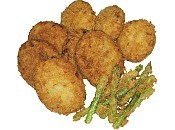
Korokke (more info) Korokke has its origins in the croquettes which were introduced to Japan in the 19th century. Korokke consist of a filling that is breaded and deep fried, and are eaten with a worcestershire tonkatsu sauce and shredded cabbage. They come in many varieties depending on the filling, the most common of which is a mix of minced meat and mashed potatoes. 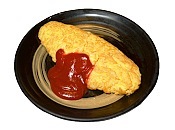
Omuraisu Omuraisu, short for omelete rice, is fried rice wrapped in a thin egg omelete. Omuraisu is usually shaped like an American football and may be garnished with ketchup or demi-glace sauce. It is a common diner or cafe food, although specialty omuraisu restaurants also exist. 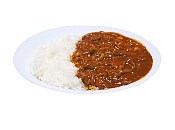
Hayashi Raisu Hayashi rice is Japanese style hashed beef stew, thinly sliced beef and onions in a demi-glace sauce served over or along side cooked rice. It resembles kare raisu, and, like kare raisu, is also eaten with a spoon. 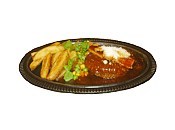
Hambagu Hambagu is Japanese style hamburger steak (as opposed to hambaga, which are hamburgers in a bun). Hambagu is usually served on a plate along side vegetables and rice or bread, and seasoned with a demi-glace sauce. 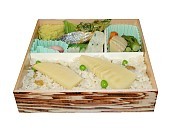
Bento Bento, or boxed meals, are inexpensive, single portion take out meals served in a box. They usually consist of small portions of meat, vegetables, fish, or pickles together with rice. Bento come in both hot and cold varieties and are sold at specialty restaurants, supermarkets, and convenience stores, and are a favorite item at train stations (ekiben) and airports (soraben). 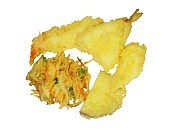
Tempura (more info) Tempura consists of seafood, vegetables, mushrooms, or meat coated with batter and deep fried. The resulting food has a light, but crispy texture, that may be seasoned with salt or dipped in a light sauce before eating. Tempura was introduced to Japan by the Portuguese in the 16th century, and has become one of Japan's most famous dishes internationally. 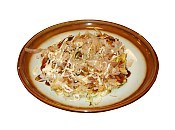
Okonomiyaki (more info) Okonomiyaki is a type of pancake where various ingredients such as seafood,vegetables and meat are mixed into a batter and grilled. Okonomiyaki specialty restaurants have a large hotplate built into the table where the patrons cook their own food. 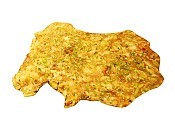
Monjayaki Monjayaki is a Kanto region specialty that is similar to okonomiyaki; however, the batter used is much thinner than okonomiyaki resulting in a moister, less uniform dish. Monjayaki is often served at okonomiyaki restaurants. 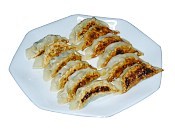
Gyoza (more info) Gyoza are dumplings stuffed with a filling made of minced vegetables and ground meat. Gyoza were introduced to Japan from China. Japanese gyoza are usually prepared by frying them, and they are commonly served as a side dish to ramen. 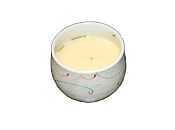
Chawanmushi Chawanmushi is savory steamed egg custard that usually contains pieces of chicken, shrimp, fish cake and a ginko nut mixed inside. It is served in a small, lidded cup, and eaten with a spoon. 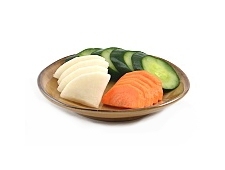
Pickles (more info) Japanese pickles, or tsukemono, come in many varieties, and are served as an appetizer, side dish, or snack, or used as a garnish or topping. They are though to aid in digestion, and a small dish of pickles is usually served with traditional Japanese meals. -
Come or no Come.
You decide.
Tourists check out a newly affordable JapanWall Street Journal -- May 10
The yen's drop is transforming Japan's reputation as a prohibitively expensive place to visit, turbocharging a tourism industry long identified as a growth engine for the maturing economy.With a dollar now fetching ¥100-up from less than ¥80 in November-foreign visitors have surged, while Japanese curb overseas travel and do more sightseeing at home.The number of foreign visitors to Japan in March, even before the yen's latest tumble, was up 26% from a year earlier to 857,000, the highest for a March since 1964, when the Japan National Tourism Organization started taking statistics.
The weaker currency has helped Japan's tourism sector overcome a number of setbacks in the past two years. The 2011 nuclear-power-plant accident scared away visitors worried about radiation. Heightened territorial tensions with Beijing have since last year led to a sharp drop in tourists from China, once the fastest-growing source of visitors to Japan. While Chinese travelers continue to shun Japan, visitors from the rest of Asia, Europe, and Russia have more than made up for the gap.
-
-
For Begnner this is good place to go
than slowly venture out, one by one.
I, also started this my first trip to Japan..
Free and Easy.
video.
-
For Begnner this is good place to go
than slowly venture out, one by one.
I, also started this my first trip to Japan..
Free and Easy.
video.
-
Something to do with this video, do you want to know more.
stayed tune, coming up soon.
video.
-
Too bad, you are not allowed.
Yoshiwara soapland bathhouses banning Chinese touristsTokyo Reporter -- May 10
According to the Japan National Tourism Organization, a record-high 1.43 million Chinese tourists visited Japan in 2012. This figure represents an increase of 37.3 percent over the year before. Monthly magazine Cyzo says that visitors from China seek out Japanese products since they are viewed to be of high quality, but one item is proving to be elusive: the prostitute.Monthly magazine Cyzo says that visitors from China seek out Japanese products since they are viewed to be of high quality, but one item is proving to be elusive: the prostitute.Bathhouses in the Yoshiwara brothel quarter are implementing a general ban on visitors from China due to "cultural differences."
"About two or three years ago, Yoshiwara started seeing a rise in the number of Chinese tourists," says an employee at one bathhouse. "Due to language difficulties, they are not able to understand the fee system."
To enter a bathhouse may require 15,000 yen, but there is also the matter of paying 30,000 yen to the awa hime, or foam princess, once the session is complete.
"There have been quarrels," continues the worker. "So as of now, Chinese tourists are not allowed to enter."
The manager of another shop says that Chinese tourists also lack appropriate manners. "Inside the bathhouses photography is prohibited," says the manager. "But Chinese tourists always want to take photos."
These photos, says the manager, eventually wind up on Web sites in China.
-
some good stuff over here
-
-
Originally posted by SBS 6078 M:
some good stuff over here
Ok..you love this kind of stuff plenty here in Fukuoka.
keep this when you are there, no regret.

-
-
-
You are lucky, you are not from that country that is banned from entering
Fukuoka regulating sex-industry guide spots
TOKYO (TR) – On April 1, Fukuoka Prefecture became the eighth administrative district in Japan to institute strict regulations on the sex-industry information booths that populate red-light districts, reports the Mainichi Shimbun (Apr. 2).The prefectural public safety commission now prohibits the guide spots, which offer information that directs potential customers to various sex-related establishments, from being located in the vicinity of schools and hospitals.
A grace period will be in effect until April 30. After that day, violators will be subject to a minimum fine of 500,000 yen and maximum prison sentence of six months.
The number of such establishments in Fukuoka Prefecture numbered 30 on March 31, 2010. Over the next 24 months, the figure rose to 44, which is the fourth highest total in Japan, following Tokyo, Osaka, and Hiroshima.
On the evening of April 1, 36 officers from the prefectural police entered the 33 guide locations in the Nakasu red-light district of Fukuoka City to confirm that signboards were not overly suggestive and, according to the Nishi Nippon Shimbun (Apr. 2), to ensure that placards prohibiting minors from entry were in place.
Kimio Nakagawa, the section chief of the community safety department of Fukuoka Prefecture, says that advertising that sexually charged photos can be a negative influence on young people. “The booths are also a source of funding for organized crime,” says the chief. “We wish to endeavor to provide a suitable environment for adult-entertainment.”
-
Too many of the above also not so good.
Let me tell you this are more better,
not much Singaporean know this place.
video.
share this here.
-

-



